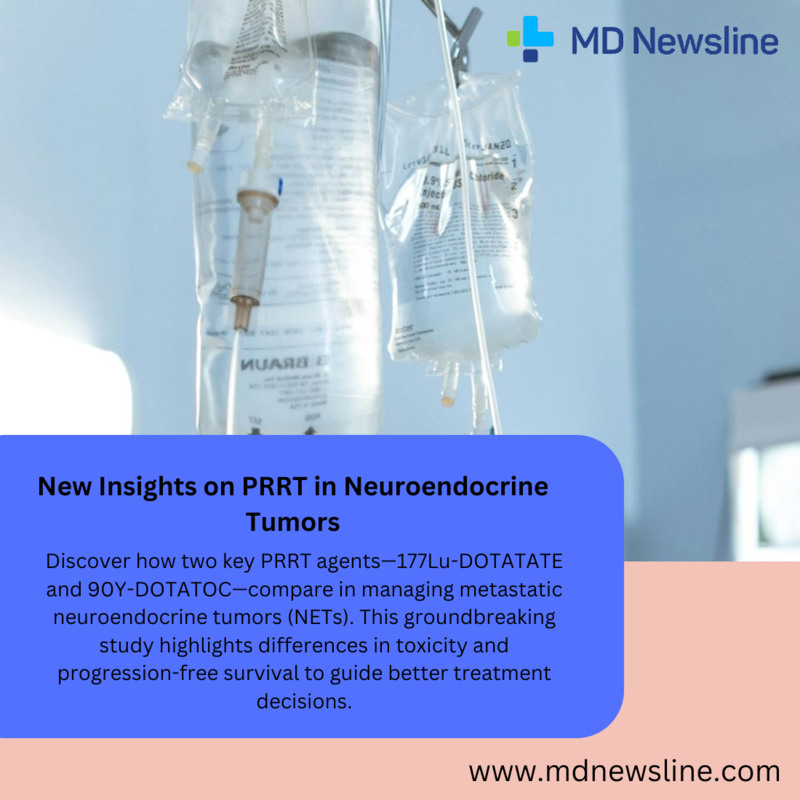


Comparing PRRT Agents in Neuroendocrine Tumors: Toxicity and Survival
A recent study analyzed renal and hematological toxicities and survival outcomes in neuroendocrine tumor patients treated with two different peptide receptor radionuclide therapy agents. The findings reveal that while renal toxicity was minimal, minor hematological toxicity occurred, and progression-free survival differed between the treatments.
Key Findings:
Peptide receptor radionuclide therapy (PRRT) is a treatment option for patients with metastatic neuroendocrine tumors (NETs). A recent study published in the Journal of Cancer Research and Clinical Oncology evaluated the renal and hematological toxicities associated with two PRRT agents: 177Lu-DOTATATE and 90Y-DOTATOC, and their impact on patient survival.
Introduction: Studies on PPRT Toxicities, Timing, and Survival Benefits Lacking
Renal and hematological toxicities are known side effects of PRRT, potentially limiting its therapeutic use. Understanding these toxicities may be important for improving patient outcomes. Additionally, optimal timing and survival benefits of PRRT have not been thoroughly examined. This study looked at changes in renal and hematological function in NET patients treated with PRRT and examined associations with overall survival (OS) and progression-free survival (PFS).
Methods: Multi-Center Retrospective Cohort Design
The researchers conducted a retrospective cohort study involving 448 NET patients from two U.S. medical centers. Among these patients, 335 received 177Lu-DOTATATE (approximately 75%), and 113 were treated with 90Y-DOTATOC (approximately 25%). Renal function was monitored through serum creatinine, blood urea nitrogen (BUN), and estimated glomerular filtration rate (eGFR). Hematological function was measured by white blood cell counts, platelet counts, and hemoglobin levels over time. Piecewise linear mixed-effect models were used to analyze longitudinal changes, and survival outcomes were evaluated using Cox proportional hazard regressions.
Results: Minimal Renal, Minor Hematological Toxicities Observed
The study found no significant differences in renal function between patients treated with 177Lu-DOTATATE and those treated with 90Y-DOTATOC prior to, during, or after PRRT. However, patients receiving 177Lu-DOTATATE showed significantly decreased indicators of hematological function before and during treatment. Specifically, there was a decrease in white blood cell counts (estimate: -0.10, 95% confidence interval (CI): -0.15 to -0.05; P < 0.001) and platelet counts (estimate: -2.53, 95% CI: -3.83 to -1.24; P < 0.001). No significant recovery in hematological function was observed post-treatment.
Conclusions: 177Lu-DOTATATE Enhanced Progression-Free Survival Without Affecting Overall Survival
While minor hematological toxicity was associated with 177Lu-DOTATATE, this agent appeared to improve progression-free survival compared to 90Y-DOTATOC (hazard ratio for PFS: 0.47, 95% CI: 0.28–0.79, P = 0.004). There was no significant difference in overall survival between the two treatments. The study concluded that treatment with 177Lu-DOTATATE may require monitoring for hematological toxicity, regardless of prior therapies.
Comparing PRRT Agents in Neuroendocrine Tumors: Understanding Toxicity and Survival Outcomes
Peptide Receptor Radionuclide Therapy (PRRT) has emerged as a promising treatment option for patients with metastatic neuroendocrine tumors (NETs). A recent study offers valuable insights into the safety and efficacy of two commonly used PRRT agents—177Lu-DOTATATE and 90Y-DOTATOC—focusing on their renal and hematological toxicities and survival outcomes. These findings shed light on optimizing treatment strategies and improving patient care.
Minimal Renal Toxicity
Both agents demonstrated stable renal function throughout the study, highlighting the minimal risk of kidney damage with PRRT.
Hematological Toxicity
Progression-Free Survival (PFS)
Patients treated with 177Lu-DOTATATE experienced significantly longer PFS compared to 90Y-DOTATOC, indicating its efficacy in delaying disease progression.
Conclusion: Advancing PRRT for Neuroendocrine Tumors
This study underscores the importance of balancing safety and efficacy in PRRT for NET patients. By identifying minimal renal toxicity and manageable hematological side effects, particularly with 177Lu-DOTATATE, it paves the way for tailored treatment strategies. Regular monitoring and patient-specific approaches will be key to optimizing outcomes in this evolving field of oncology.
Visit our website today to uncover: Comparing PRRT Agents in Neuroendocrine Tumors: Toxicity and Survival
